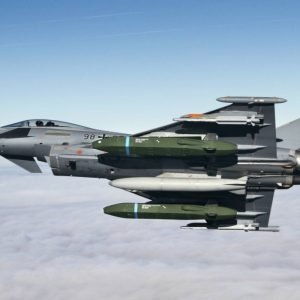
The UK Ministry of Defence (MoD) issued a notice to industry on 25 September 2024 outlining specifications for a new long-range weapon system.
Known as Project Brakestop, the forthcoming industrial competition will provide the British Armed Forces with a one-way effector to be launched from a mobile ground-based platform.
The target cost per unit must be no higher than £400,000, excluding VAT and the launcher system. Subject to potential future contract, manufacturing shall be scalable to meet operational requirements at a minimum of 20 units per month, with the ability to scale up.
MoD requirements
The new effector is anticipated to reach a range greater than 500km. This exceeds the Anglo-French air-launched Storm Shadow cruise missile, which travels up to 250km; the American-made Harpoon anti-ship cruise missile, at 240km; and the local air defence CAMM missile, at 25km—all of which feature in the British arsenal.
The MoD request that the weapon be resilient in harsh physical environments, day and night. The effector must have a low multispectral signature, be resilient in a complex electromagnetic environment, including within a GNSS-denied and degraded environment, and be resistant against targeted electronic warfare attacks and spoofing.
Furthermore, the weapon will weigh between 200 and 300kg (class payload mark 82 for reference) and travel 600km per hour.
Access the most comprehensive Company Profiles
on the market, powered by GlobalData. Save hours of research. Gain competitive edge.

Company Profile – free
sample
Your download email will arrive shortly
We are confident about the
unique
quality of our Company Profiles. However, we want you to make the most
beneficial
decision for your business, so we offer a free sample that you can download by
submitting the below form
By GlobalData
The concept can operate at any trajectory (ballistic or low-level cruise) and could use a missile, a drone, or another technology to deliver the effect, day or night, following a pre-programmed route.
If low level cruise, it must be able to navigate in a GNSS denied environment and have some form of end stage guidance as required, to an accuracy of CEP (0.5) of 30 metres.
Sovereignty is key
Learning from Ukraine, the British government emphasised that the design of its new effector must be free from external government trade and usage restrictions.
In the past month, Ukraine has repeatedly called on the US to approve the use of long-range weapons against targets inside Russia. It is important to eliminate such targets – acting as airbases and launching sites – as they enable invading Russian forces to wage a destructive campaign against Ukraine’s civil and military infrastructure.
Just yesterday (29 September), a Russian salvo “hit ordinary residential buildings, ordinary city facilities,” confirmed Ukraine’s President, Volodymyr Zelenskyy.
American components power the weapon systems in Ukrainian hands, so their unrestricted use hinges on US approval. Nevertheless, this has not stopped other Western backers, such as Britain, France, and Italy, from offering their approval for the use of their long-range weapons inside Russia.
In response to this ongoing debate, the Ukrainian industry is said to have developed an indigenous long-range weapon system that meets several of the British requirements for Project Brakestop, including a range of up to 600km.
This domestically produced missile-drone hybrid is known as the ‘Palianytsia’. In early September, Lithuania announced that it would invest €10m in Ukraine’s long-range weapon.








